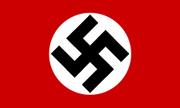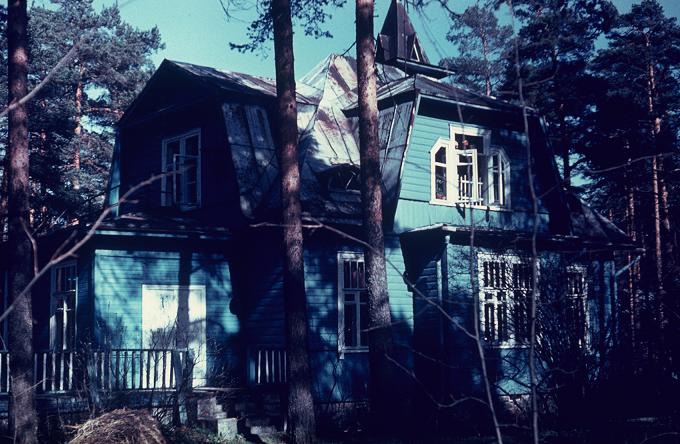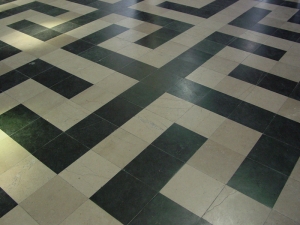Lonely Planet Moscow
"Lonely Planet" is a series of travel guides to help tourists with their travel destinations. The video above is an example of their travel guide. One can check for more videos in their youtube page.
These travel guides span a whole list of countries, from Thailand to Switzerland, Afghanistan to India, you name it, they have it. Having Cayce possess this book, as a way to orient herself to Russia, is not that surprising. Typically, people would want to have a background of the country they're going to to help them move around and familiarize themselves about the place. Also, most of the time, these travel guides would give suggestions to the reader on places worth going to in the country. However, it's interesting to note that Cayce is here for "business" and not really for leisure.
M18A1 Claymore Mine

(image from www.af.mil )
Above is the M18A1 Claymore mine being talked about at the end of the chapter. It is described in the book as
…basically a wad of C4 explosive packed behind 700 steel balls. When the C4 goes off, the balls come out in a 60 [degree] pattern that expands to six feet; anything closer than 170 feet … is thereby made hamburger.
Reading this, one can feel how scary this kind of contraption is. The fact that it was used in wars before and knowing that it might still be in use today is quite unnerving. And, since mines are usually hidden from sight, going off only when one triggers it, it's quite scary that one might trip on it one day. There are still stories, especially from countries where wars happened before, that mines set off decades after putting them there.
Aeroflot

(image from www.easypedia.gr)
Aeroflot is a Russian airline mentioned in this chapter. Cayce rode on an Aeroflot flight SU244 which would depart from Heathrow and would land in Moscow. Now, it's funny that Cayce here experiences "pseudo-nostalgia" about Aeroflot. She thinks about how her dad's stories of Aeroflot are a bit bad, given that there were 'vicious flight attendants' and that they served 'stale sandwiches'. It's weird how this "pseudo-nostalgia" was triggered because of her decent legroom. What she remembered was a bad memory which popped up because of something not quite bad. Aeroflot is a real Russian airline. The picture above is its logo and one can see that it contains the hammer and the sickle. It's very ironic that a Russian airline has this as its logo and yet Russia now is no longer a communist state.
BIANCA PAOLA S. BALUYUT, 070350, Com12 A
Chapter 33, entitled “Bot”, is one of the most fascinating chapters in Pattern Recognition, as it hits various discourses at the same time: the historical atrocity of Nazi Germany, the McDonaldization of Russia, explicit namedropping of famous postmodernist thinkers, presence of Internet robots, etc.
1) Swastika
It is interesting to note Cayce’s tolerance with national icons, except the Nazi Germany-associated “Swastika”.
Etymology: The word swastika is derived from the Sanskrit svastika, meaning any lucky or auspicious object. Contrary to what most people believe, this icon was not designed by the Germans – it has been present earlier than the Second World War since it is an important symbol in Hinduism, Buddhism, Native American faiths, etc. This icon has been very ubiquitous in art and architecture.
The swastika was eventually adopted by the Nazi Party (Nationalsozialistische Deutsche Arbeiterpartei or NSDAP) headed by Fuhrer Adolf Hitler. It was evident in Hitler’s piece called Mein Kampf that the symbol is chosen because it represents "the fight for the victory of Aryan man". Hence, the Swastika was linked to the Holocaust, racism, fascism and the World War II.


Nazists embedded the swastika in their armbands, badges and more. In any way, most people would find this reminiscent of the historical violence, this was somehow banned by most countries, including Germany.
It's just strange how Cayce is allergic to the swastika not entirely due to "historical evil…as from an awareness of a scary excess of design talent". The image indeed is so enigmatic, with the red-white-black combination. The emblem itself has "mirror-image forms have 90° rotational symmetry… composed of 17 squares in a 5x5 grid."
Analyzing the clockwise-counterclockwise positioning and geometrical aspects of this icon would leave one hypnotized by the quasi-symmetry it exudes. No wonder Cayce found it worse than Tommy Hilfiger. Cayce abhorred the symbol but for its ubiquity as this is embedded in some bags, accessories, clothing, etc.
2) McDonaldization in Russia/Consumerist Society in Russia
Gibson wrote several references that proved the emergence of New Russia — a departure from a socialist status and an arrival to the current system — capitalism. Cayce detected such through the manifestation of the following:
1) "Russia serves Pepsi." (page 277); 2) "Billboards for computers, luxury goods, and electronics appear, increasing in number and variety as they approach the [Moscow] city." (page 279); 3) "Then a McDonald's, seemingly as large…Huge advertising banners are slung across the street, and billboards top most buildings." (page 280).

The end of Cold War in the early 90s also marked the end of Russian "centrally planned economy", which gives sole economic power to the government rather than the private sector for product development and distribution. This translates to little variety of products and slow execution of various economic plans. In this regard, the ideas of socialism (like the planned economy) were crafted to remedy the ills brought about by capitalism (unequal distribution of wealth, social classes); however, it failed because this only paved the way for black markets and moonlighting in communist states (the act of doing multiple jobs at a time).
But New Russia is now operating in a market economy, as exemplified through its consumerist attitude and relentless subscription to advertisements, billboards and luxury products. Multinational corporations, like McDonald's, took Russia and China by storm. For example, McDonald's presently manages 103 restaurants in Moscow and other Russian regions, "serving 200,000 customers every day". (For more on McDonald's Russia, click here). This showed the complete deviation from Lenin's ideologies.
However, Russia's ominous transition was not smooth because the transfer of properties and funds from the state to the private sector was tainted with anomalies. These were handed to the country's oligarchs, which do not benefit children, elderly and workers to this day. Corrupt businessmen succeeded and lawlessness proliferated. (Capitalism in the New Russia by Daniel Michaels)
3) Russian architecture
Describing Russian architecture can be condensed into one word: huge. Cayce first notices the intricate details of infrastructures in Moscow:
"Her first impression of Moscow itself is that everything is far larger than it could possibly have any need to be. Cyclopean Stalin-era buildings in burnt orange brick, their detailing vaguely maroonish. Built to humble, and terrify. But lampposts, fountains, plazas, all partake of this exaggerated scale." (page 279)
Stalinist architecture, coined during 1933 to 1955 under the leadership of Joseph Stalin, was a structural style returning to conservatism. It is characterized by gigantism and it reflected several different styles including Neo- Renaissance, classicism, and constructivism.4 The greatest examples of Stalinist architecture are the Seven Sisters (skyscrapers built during the Stalin's last years; it is an evident combination of Russian Baroque style and high technology American edifice design), earning the nickname "Wedding Cake" because of the tiered forms. Moscow State University building is probably the most famous structure of the seven:

Hotel Ukrania

Russian architecture, during the post-revolution period, welcomed Palace of Culture or worker's clubhouse which demonstrated large elements plus an industrial feel. This is the reason why Soviet Russia built large infrastructures — this caters to the working class or the masses. Because communality is fostered, public spaces have become a central feature of Socialist states.
Photo Source5
4) Internet Bots
The title of the chapter boils down to Parkaboy's news about Darryl and his "buddy"'s breakthrough on deciphering the T-shaped map. In his email, Parkaboy specified details by how the latter managed to detect visual similarities among graphics or photos through an advanced technology:
"Darryl got all hacker on that, with this buddy of his in Palo Alto who's on a project to build a new kind of visually based search engine. Buddy has these bots that are CAD-CAM (Acronym for computer-aided design/computer-aided manufacturing computer systems used to design and manufacture products) based, look for things on the basis of how they're shaped. (page 284)
An Internet bot is " a software program that performs tasks over the Internet in an automated manner that is much faster than a person would be able to do. Although it is software, an Internet bot interacts with network services intended for people as if it were a person. Some Internet bots are harmless and useful, but some are dangerous."6
An example of which is the Web Crawler (used by search engines like Google and Yahoo) to surf through the Internet and systematically lists down information.
Search engines are highly significant tools in the age of the World Wide Web because it delivers the set of results within a fraction of a second in an organized manner. Google, a content-based search engine, enables Internet users to type keywords which generate a maximum of 1,000 results. Google is probably the most popular website at this point.
This might not be known to a lot of people, but visually based search engines (like what Darryl's friend created) exist in cyberspace. Through the input of a certain image, the bots would then search for other photos or graphics that matched the given image. An epitome for this would be a program named Xcavator, the visual search engine that lets professional designers and others find images they want and buy them.
An article entitled, "Visual search engine Xcavator launches", it was emphasized that:
Take an example. Let’s say you want an image of an old-fashioned popcorn box. You type in popcorn in the seach bar, and Xcavator provides results. Ok, so there are a couple of popcorn boxes. But, lets say you want to find variations of the red popcorn box on the second row (see below). You drag the red popcorn box image to a place beside the search bar, and Xcavator looks for images just like it. You can then use a hue and a intensity tools (the circle and orb to the left) to find popcorn box images that are say, red, and in a dark background for example.
Watch the video to see how it works:
The systematic, efficient and fast performance of Internet bots paved the way for business moguls to rake in profits through advertising of products and services displayed in search results (for search engines).
5) Intellectual snobbery
In this chapter, Mama Anarchia makes a grand comment that would probably bleed our noses to death. She wrote her first post at F:F:F with noticeably confident tone:
"Really it is entirely about story, though not in any sense that any of you seem familiar with. Do you know nothing of narratology? Where is Derridean "play" and excessiveness? Foucauldian limit-attitude? Lyotardian language-games? Lacanian Imaginaries? Where is the commitment to praxis, positioning Jamesonian nostalgia, and despair — as well as Habermasian fears of irrationalism — as panic discourses signaling the defeat of Enlightenment hegemony over cultural theory? But no: discourses on this site are hopelessly retrograde. Mama Anarchia" (page 278)
This is intellectual snobbery at its finest, which is rampant in forums, blogs and even during classroom discussions. The explicit name-dropping of famous postmodernist thinkers by Mama epitomizes her erudition over the others. Those who do not know or not familiar with Michel Foucault, Jean-Francois Lyotard or Jacques Derrida would most likely be stereotyped by these snobs as scholastically inferior. The thing with intellectual snobs is that they unconsciously carry a pretentious aura — as David Blackburn writes an entry entitled "Give Us This Day Our Daily Ciabatta" in The Oxford Student website. He also provided amusing examples:
"Snobs who recline in the corner of the college bar, reading Baudelaire aloud, and describing men and women who are a little beyond being attractively plump in terms of “displaying the archetypal rudiments of Renaissance beauty” are innumerable.
He also added that:
Intellectual snobs, social snobs and inverse snobs inharmoniously co-exist in libraries, bars and coffee shops. Even in soulless and crass Starbucks the cravat clad, shell-suited and army surplus-clothed troupes can be heard pom-pomming away about books they’ve never read, drinks they’ve never drunk, drugs they’ve never taken, places they’ve never been, people they’ve never met and ideas that none of us will ever fully understand.
Clearly, Mama Anarchia is a snob as she dismissed simplistic theories with regards to the creation of the footage. She described the other footageheads' interpretations as "hopelessly retrograde". Thus, snobbery as a whole is a recurring theme all throughout the novel.
6) Art Nouveau
Gibson introduces Art Nouveau when Cayce notices a train station structured to that style. She stresses that:
Off to the right, she sees an enormous Art Nouveau train station, a survival from an earlier era still, but on a scale to dwarf London's grandest.
Its interiors probably look like this (Maison & Atelier of Victor Horta in Brussels, Belgium):

Art Nouveau, or New Art in French, is an international movement based on a new style of architecture, which values aesthetics alongside with technology. Old customs and traditions were linked with technology-driven lifestyles and identities. Somehow, this is a response to the Industrial Revolution where artists utilized the cast iron as a tool or subject for endless aesthetic possibilities. Art Nouveau architects believe in the idea of Gesamtkunstwerk or ""total work of art", that all elements must be in harmony with each other.8
This movement is still considered "modern" in Russia because Stalinist architecture defined the country's look. However, Art Nouveau architecture flourished in Russia, and is most apparent in modern-day St. Petersburg. Famous artists such as Alexei Bubyr, Paul Susor and Fedor Lidval decorated the area with neo-Renaissance and pseudo-Russia designs.


For more on Russia and Art Nouveau, click here.
Chapter 33 indeed presents a brand new dimension for Cayce Pollard, a very different picture painted about New York, London and Tokyo. The stage is now bestowed upon Russia, the other global superpower.












